Digital Natives, Innovation, and Leadership in the Modern Workplace
VerifiedAdded on 2022/12/26
|7
|1110
|41
Report
AI Summary
This report provides an in-depth analysis of digital natives, their skills, and the leadership challenges associated with motivating them. It defines digital natives and outlines their common abilities, such as technological literacy and multitasking, while also highlighting leadership barriers, including the inability to adhere to linear problem-solving structures and the technology gap between leaders and digital native workers. The report then differentiates between change and mega change, providing examples of each and explaining the importance of innovation in the corporate world, including incremental, disruptive, and radical innovation. Furthermore, it defines decision architects, explores the reasons for poor decisions, and suggests methods for improvement. Finally, the report examines models of corporate entrepreneurship, focusing on the producer model and its characteristics, along with real-world examples of its application. The report concludes that digital natives are helpful in creating a successful business and that decision architects and corporate entrepreneur models are useful for organizational success.
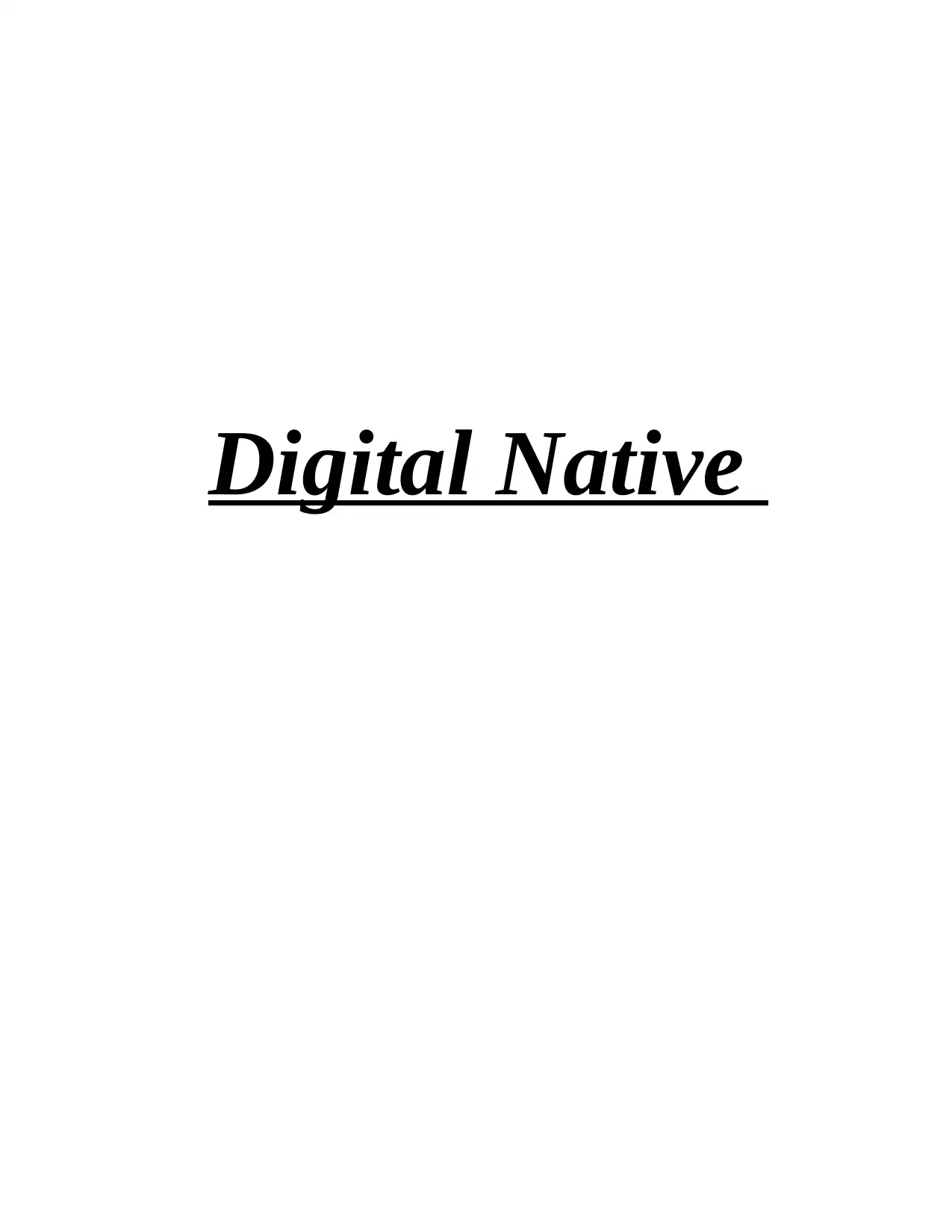
Digital Native
Paraphrase This Document
Need a fresh take? Get an instant paraphrase of this document with our AI Paraphraser
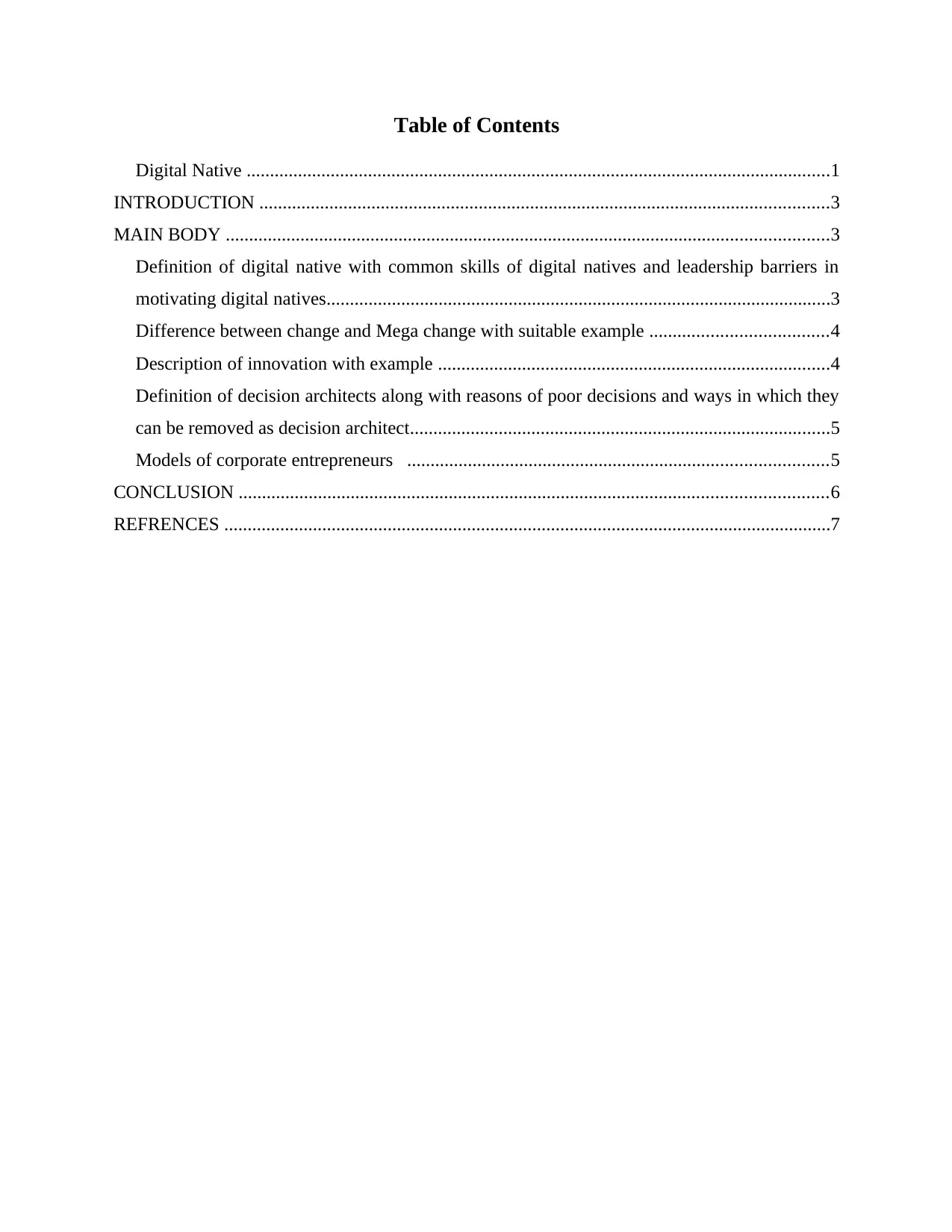
Table of Contents
Digital Native .............................................................................................................................1
INTRODUCTION ..........................................................................................................................3
MAIN BODY .................................................................................................................................3
Definition of digital native with common skills of digital natives and leadership barriers in
motivating digital natives............................................................................................................3
Difference between change and Mega change with suitable example ......................................4
Description of innovation with example ....................................................................................4
Definition of decision architects along with reasons of poor decisions and ways in which they
can be removed as decision architect..........................................................................................5
Models of corporate entrepreneurs ..........................................................................................5
CONCLUSION ..............................................................................................................................6
REFRENCES ..................................................................................................................................7
Digital Native .............................................................................................................................1
INTRODUCTION ..........................................................................................................................3
MAIN BODY .................................................................................................................................3
Definition of digital native with common skills of digital natives and leadership barriers in
motivating digital natives............................................................................................................3
Difference between change and Mega change with suitable example ......................................4
Description of innovation with example ....................................................................................4
Definition of decision architects along with reasons of poor decisions and ways in which they
can be removed as decision architect..........................................................................................5
Models of corporate entrepreneurs ..........................................................................................5
CONCLUSION ..............................................................................................................................6
REFRENCES ..................................................................................................................................7
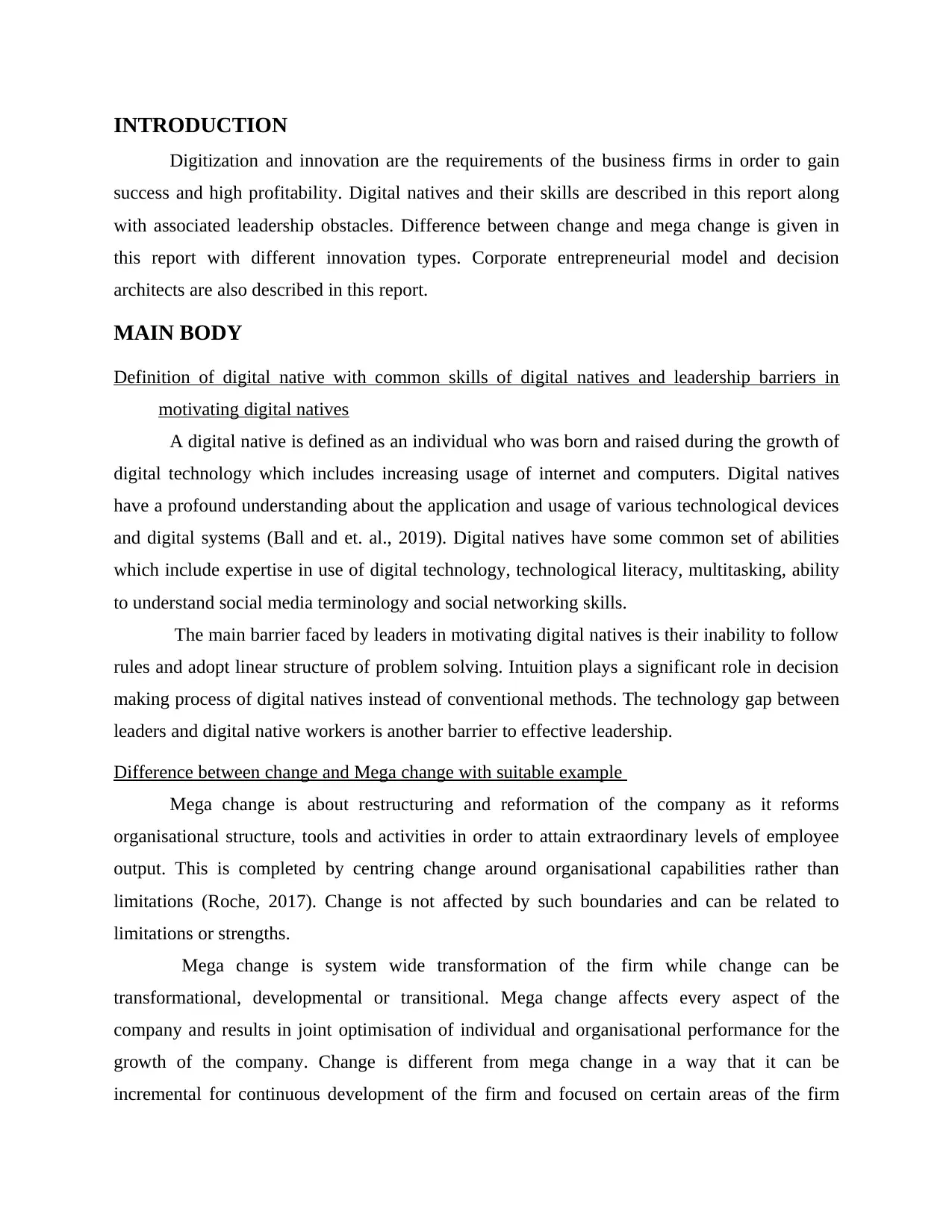
INTRODUCTION
Digitization and innovation are the requirements of the business firms in order to gain
success and high profitability. Digital natives and their skills are described in this report along
with associated leadership obstacles. Difference between change and mega change is given in
this report with different innovation types. Corporate entrepreneurial model and decision
architects are also described in this report.
MAIN BODY
Definition of digital native with common skills of digital natives and leadership barriers in
motivating digital natives
A digital native is defined as an individual who was born and raised during the growth of
digital technology which includes increasing usage of internet and computers. Digital natives
have a profound understanding about the application and usage of various technological devices
and digital systems (Ball and et. al., 2019). Digital natives have some common set of abilities
which include expertise in use of digital technology, technological literacy, multitasking, ability
to understand social media terminology and social networking skills.
The main barrier faced by leaders in motivating digital natives is their inability to follow
rules and adopt linear structure of problem solving. Intuition plays a significant role in decision
making process of digital natives instead of conventional methods. The technology gap between
leaders and digital native workers is another barrier to effective leadership.
Difference between change and Mega change with suitable example
Mega change is about restructuring and reformation of the company as it reforms
organisational structure, tools and activities in order to attain extraordinary levels of employee
output. This is completed by centring change around organisational capabilities rather than
limitations (Roche, 2017). Change is not affected by such boundaries and can be related to
limitations or strengths.
Mega change is system wide transformation of the firm while change can be
transformational, developmental or transitional. Mega change affects every aspect of the
company and results in joint optimisation of individual and organisational performance for the
growth of the company. Change is different from mega change in a way that it can be
incremental for continuous development of the firm and focused on certain areas of the firm
Digitization and innovation are the requirements of the business firms in order to gain
success and high profitability. Digital natives and their skills are described in this report along
with associated leadership obstacles. Difference between change and mega change is given in
this report with different innovation types. Corporate entrepreneurial model and decision
architects are also described in this report.
MAIN BODY
Definition of digital native with common skills of digital natives and leadership barriers in
motivating digital natives
A digital native is defined as an individual who was born and raised during the growth of
digital technology which includes increasing usage of internet and computers. Digital natives
have a profound understanding about the application and usage of various technological devices
and digital systems (Ball and et. al., 2019). Digital natives have some common set of abilities
which include expertise in use of digital technology, technological literacy, multitasking, ability
to understand social media terminology and social networking skills.
The main barrier faced by leaders in motivating digital natives is their inability to follow
rules and adopt linear structure of problem solving. Intuition plays a significant role in decision
making process of digital natives instead of conventional methods. The technology gap between
leaders and digital native workers is another barrier to effective leadership.
Difference between change and Mega change with suitable example
Mega change is about restructuring and reformation of the company as it reforms
organisational structure, tools and activities in order to attain extraordinary levels of employee
output. This is completed by centring change around organisational capabilities rather than
limitations (Roche, 2017). Change is not affected by such boundaries and can be related to
limitations or strengths.
Mega change is system wide transformation of the firm while change can be
transformational, developmental or transitional. Mega change affects every aspect of the
company and results in joint optimisation of individual and organisational performance for the
growth of the company. Change is different from mega change in a way that it can be
incremental for continuous development of the firm and focused on certain areas of the firm
⊘ This is a preview!⊘
Do you want full access?
Subscribe today to unlock all pages.

Trusted by 1+ million students worldwide
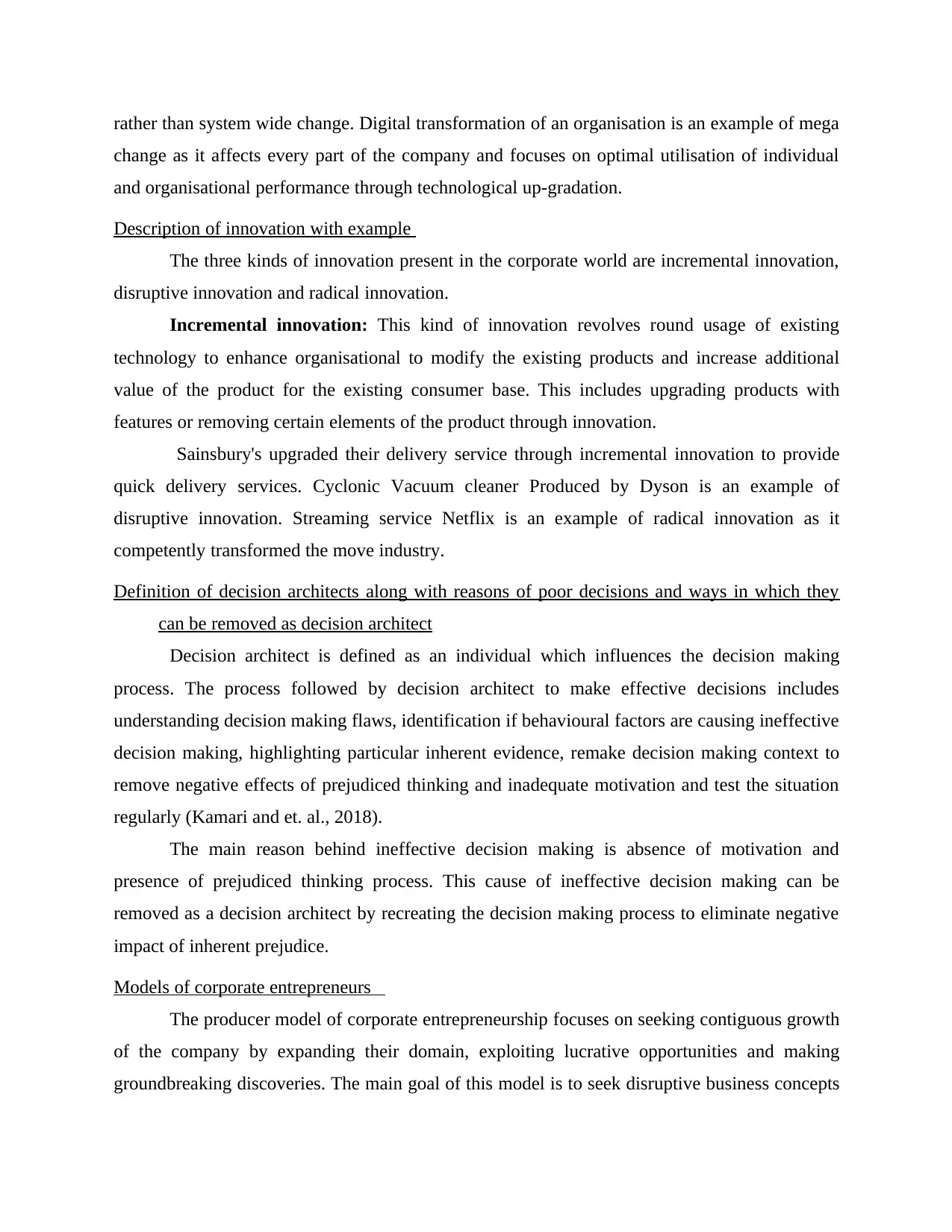
rather than system wide change. Digital transformation of an organisation is an example of mega
change as it affects every part of the company and focuses on optimal utilisation of individual
and organisational performance through technological up-gradation.
Description of innovation with example
The three kinds of innovation present in the corporate world are incremental innovation,
disruptive innovation and radical innovation.
Incremental innovation: This kind of innovation revolves round usage of existing
technology to enhance organisational to modify the existing products and increase additional
value of the product for the existing consumer base. This includes upgrading products with
features or removing certain elements of the product through innovation.
Sainsbury's upgraded their delivery service through incremental innovation to provide
quick delivery services. Cyclonic Vacuum cleaner Produced by Dyson is an example of
disruptive innovation. Streaming service Netflix is an example of radical innovation as it
competently transformed the move industry.
Definition of decision architects along with reasons of poor decisions and ways in which they
can be removed as decision architect
Decision architect is defined as an individual which influences the decision making
process. The process followed by decision architect to make effective decisions includes
understanding decision making flaws, identification if behavioural factors are causing ineffective
decision making, highlighting particular inherent evidence, remake decision making context to
remove negative effects of prejudiced thinking and inadequate motivation and test the situation
regularly (Kamari and et. al., 2018).
The main reason behind ineffective decision making is absence of motivation and
presence of prejudiced thinking process. This cause of ineffective decision making can be
removed as a decision architect by recreating the decision making process to eliminate negative
impact of inherent prejudice.
Models of corporate entrepreneurs
The producer model of corporate entrepreneurship focuses on seeking contiguous growth
of the company by expanding their domain, exploiting lucrative opportunities and making
groundbreaking discoveries. The main goal of this model is to seek disruptive business concepts
change as it affects every part of the company and focuses on optimal utilisation of individual
and organisational performance through technological up-gradation.
Description of innovation with example
The three kinds of innovation present in the corporate world are incremental innovation,
disruptive innovation and radical innovation.
Incremental innovation: This kind of innovation revolves round usage of existing
technology to enhance organisational to modify the existing products and increase additional
value of the product for the existing consumer base. This includes upgrading products with
features or removing certain elements of the product through innovation.
Sainsbury's upgraded their delivery service through incremental innovation to provide
quick delivery services. Cyclonic Vacuum cleaner Produced by Dyson is an example of
disruptive innovation. Streaming service Netflix is an example of radical innovation as it
competently transformed the move industry.
Definition of decision architects along with reasons of poor decisions and ways in which they
can be removed as decision architect
Decision architect is defined as an individual which influences the decision making
process. The process followed by decision architect to make effective decisions includes
understanding decision making flaws, identification if behavioural factors are causing ineffective
decision making, highlighting particular inherent evidence, remake decision making context to
remove negative effects of prejudiced thinking and inadequate motivation and test the situation
regularly (Kamari and et. al., 2018).
The main reason behind ineffective decision making is absence of motivation and
presence of prejudiced thinking process. This cause of ineffective decision making can be
removed as a decision architect by recreating the decision making process to eliminate negative
impact of inherent prejudice.
Models of corporate entrepreneurs
The producer model of corporate entrepreneurship focuses on seeking contiguous growth
of the company by expanding their domain, exploiting lucrative opportunities and making
groundbreaking discoveries. The main goal of this model is to seek disruptive business concepts
Paraphrase This Document
Need a fresh take? Get an instant paraphrase of this document with our AI Paraphraser
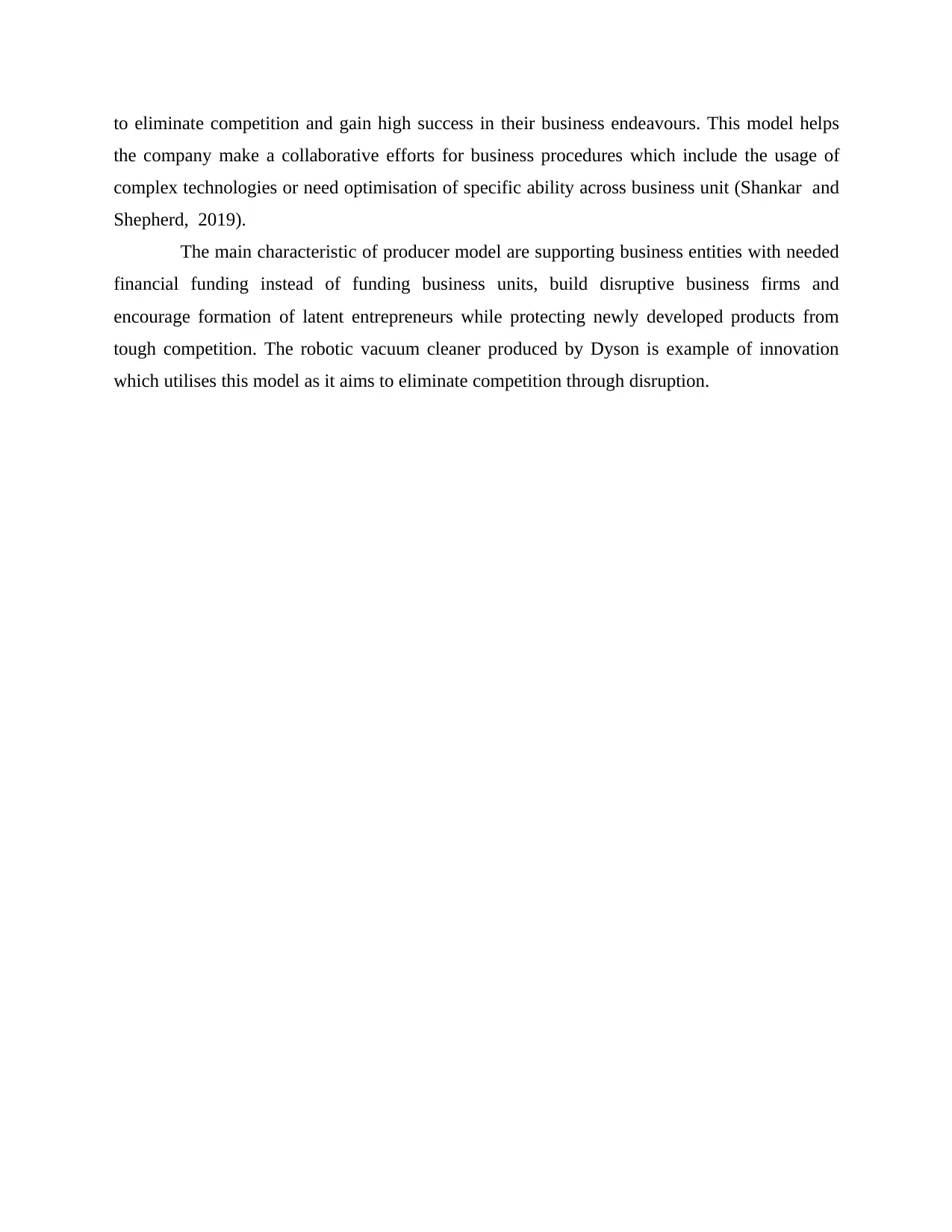
to eliminate competition and gain high success in their business endeavours. This model helps
the company make a collaborative efforts for business procedures which include the usage of
complex technologies or need optimisation of specific ability across business unit (Shankar and
Shepherd, 2019).
The main characteristic of producer model are supporting business entities with needed
financial funding instead of funding business units, build disruptive business firms and
encourage formation of latent entrepreneurs while protecting newly developed products from
tough competition. The robotic vacuum cleaner produced by Dyson is example of innovation
which utilises this model as it aims to eliminate competition through disruption.
the company make a collaborative efforts for business procedures which include the usage of
complex technologies or need optimisation of specific ability across business unit (Shankar and
Shepherd, 2019).
The main characteristic of producer model are supporting business entities with needed
financial funding instead of funding business units, build disruptive business firms and
encourage formation of latent entrepreneurs while protecting newly developed products from
tough competition. The robotic vacuum cleaner produced by Dyson is example of innovation
which utilises this model as it aims to eliminate competition through disruption.
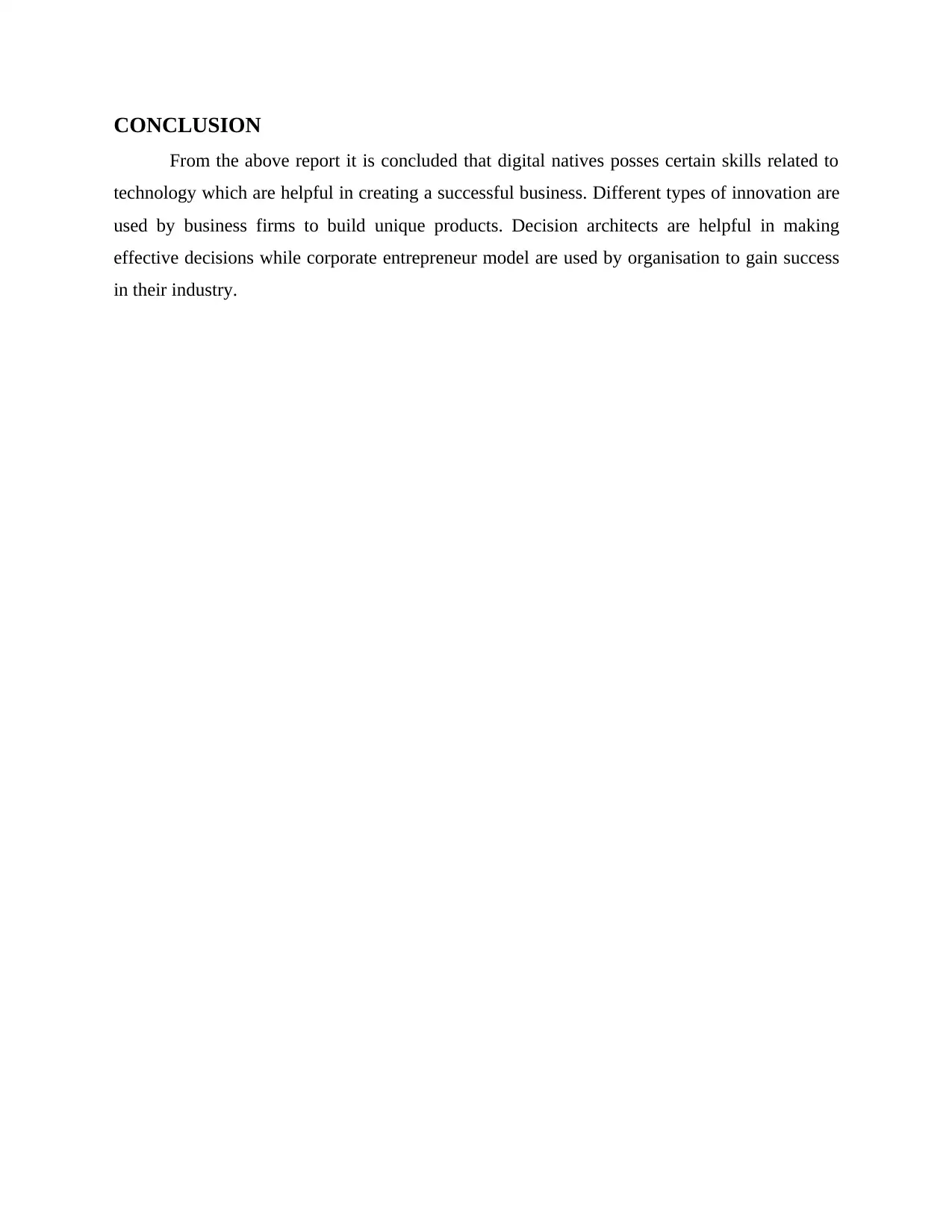
CONCLUSION
From the above report it is concluded that digital natives posses certain skills related to
technology which are helpful in creating a successful business. Different types of innovation are
used by business firms to build unique products. Decision architects are helpful in making
effective decisions while corporate entrepreneur model are used by organisation to gain success
in their industry.
From the above report it is concluded that digital natives posses certain skills related to
technology which are helpful in creating a successful business. Different types of innovation are
used by business firms to build unique products. Decision architects are helpful in making
effective decisions while corporate entrepreneur model are used by organisation to gain success
in their industry.
⊘ This is a preview!⊘
Do you want full access?
Subscribe today to unlock all pages.

Trusted by 1+ million students worldwide
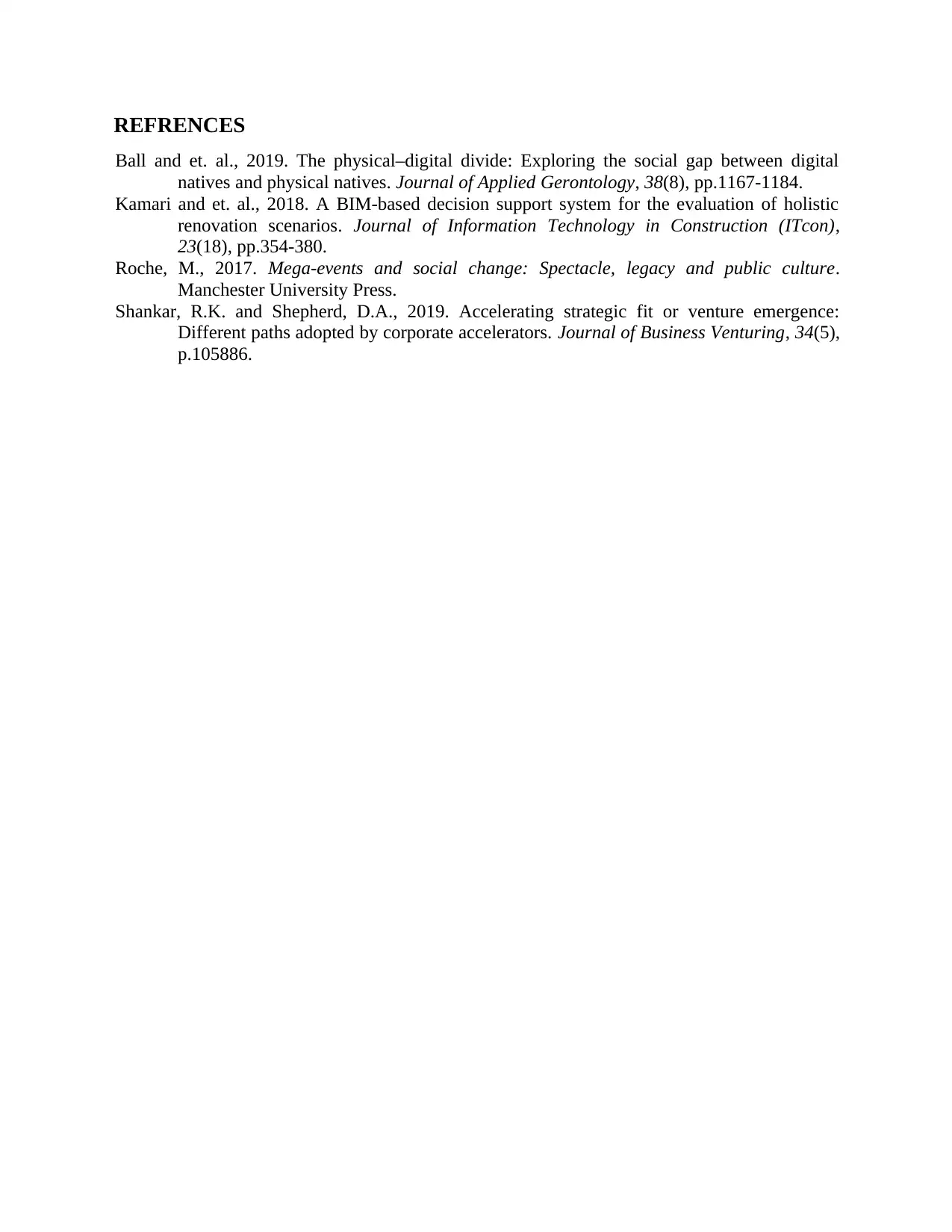
REFRENCES
Ball and et. al., 2019. The physical–digital divide: Exploring the social gap between digital
natives and physical natives. Journal of Applied Gerontology, 38(8), pp.1167-1184.
Kamari and et. al., 2018. A BIM-based decision support system for the evaluation of holistic
renovation scenarios. Journal of Information Technology in Construction (ITcon),
23(18), pp.354-380.
Roche, M., 2017. Mega-events and social change: Spectacle, legacy and public culture.
Manchester University Press.
Shankar, R.K. and Shepherd, D.A., 2019. Accelerating strategic fit or venture emergence:
Different paths adopted by corporate accelerators. Journal of Business Venturing, 34(5),
p.105886.
Ball and et. al., 2019. The physical–digital divide: Exploring the social gap between digital
natives and physical natives. Journal of Applied Gerontology, 38(8), pp.1167-1184.
Kamari and et. al., 2018. A BIM-based decision support system for the evaluation of holistic
renovation scenarios. Journal of Information Technology in Construction (ITcon),
23(18), pp.354-380.
Roche, M., 2017. Mega-events and social change: Spectacle, legacy and public culture.
Manchester University Press.
Shankar, R.K. and Shepherd, D.A., 2019. Accelerating strategic fit or venture emergence:
Different paths adopted by corporate accelerators. Journal of Business Venturing, 34(5),
p.105886.
1 out of 7
Related Documents
Your All-in-One AI-Powered Toolkit for Academic Success.
+13062052269
info@desklib.com
Available 24*7 on WhatsApp / Email
![[object Object]](/_next/static/media/star-bottom.7253800d.svg)
Unlock your academic potential
Copyright © 2020–2025 A2Z Services. All Rights Reserved. Developed and managed by ZUCOL.
![Leadership Assessment 2: Change Management Report - [University Name]](/_next/image/?url=https%3A%2F%2Fdesklib.com%2Fmedia%2Fimages%2F946a01eb6c4b4cfaa8ccf8aee3541080.jpg&w=256&q=75)




